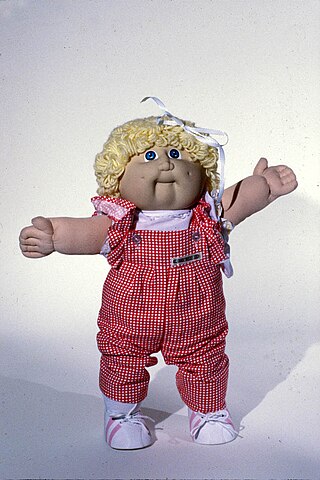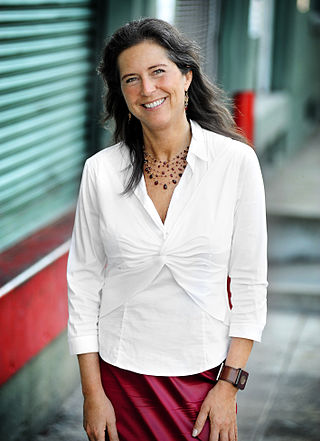
Mattel, Inc. is an American multinational toy manufacturing and entertainment company founded in Los Angeles by Harold Matson and the husband-and-wife duo of Ruth and Elliot Handler in January 1945 and headquartered in El Segundo, California. Mattel has a presence in 35 countries and territories; its products are sold in more than 150 countries.

Cabbage Patch Kids are a line of cloth dolls with plastic heads first produced by Coleco Industries in 1982. They were inspired by the Little People soft sculptured dolls sold by Xavier Roberts as collectibles. The brand was renamed 'Cabbage Patch Kids' by Roger L. Schlaifer when he acquired the exclusive worldwide licensing rights in 1982.

A toy or plaything is an object that is used primarily to provide entertainment. Simple examples include toy blocks, board games, and dolls. Toys are often designed for use by children, although many are designed specifically for adults and pets. Toys can provide utilitarian benefits, including physical exercise, cultural awareness, or academic education. Additionally, utilitarian objects, especially those which are no longer needed for their original purpose, can be used as toys. Examples include children building a fort with empty cereal boxes and tissue paper spools, or a toddler playing with a broken TV remote control. The term "toy" can also be used to refer to utilitarian objects purchased for enjoyment rather than need, or for expensive necessities for which a large fraction of the cost represents its ability to provide enjoyment to the owner, such as luxury cars, high-end motorcycles, gaming computers, and flagship smartphones.

Barbie is a fashion doll created by American businesswoman Ruth Handler, manufactured by American toy and entertainment company Mattel and introduced on March 9, 1959. The toy was based on the German Bild Lilli doll which Handler had purchased while in Europe. The figurehead of an eponymous brand that includes a range of fashion dolls and accessories, Barbie has been an important part of the toy fashion doll market for over six decades. Mattel has sold over a billion Barbie dolls, making it the company's largest and most profitable line. The brand has expanded into a multimedia franchise since 1984, including video games, animated films, television/web series, and a live-action film.

Ruth Marianna Handler was an American business magnate and inventor. She is best known for inventing the Barbie doll in 1959, and being co-founder of toy manufacturer Mattel with her husband Elliot, as well as serving as the company's first president from 1945 to 1975.

Bratz is an American fashion doll and media franchise created by former Mattel employee Carter Bryant for MGA Entertainment, which debuted in 2001.
John W. Ryan was an American designer. Ryan worked at toy company Mattel for 20 years, becoming the company's vice president of research and development, and subsequently working as a consultant. He was responsible for the Barbie doll, Hot Wheels, and Chatty Cathy. He was the sixth husband of actress Zsa Zsa Gabor.
Polly Pocket is a toy line of dolls and accessories first founded and designed by Chris Wiggs in 1983 and licensed by Bluebird Toys from 1989 until both entities/properties were acquired by Mattel in 1998.
Chatty Cathy was a pull-string "talking" doll originally created by Ruth and Elliot Handler and manufactured by the Mattel toy company from 1959 to 1965. The doll was first released in stores and appeared in television commercials beginning in 1960, with a suggested retail price of $18.00, though usually priced under $10.00 in catalog advertisements. Chatty Cathy was on the market for six years and was the second most popular doll of the 1960s after Barbie.
American Girl is an American line of 18-inch (46 cm) dolls released on May 5, 1986, by Pleasant Company. The dolls portray eight- to fourteen-year-old girls of various ethnicities, faiths, nationalities, and social classes throughout different time periods throughout history. They are sold with accompanying books told from the viewpoint of the girls. Originally the stories focused on various periods of American history, but were expanded to include characters and stories from contemporary life. Aside from the original American Girl dolls, buyers also have the option to purchase Truly Me dolls, which vary by eye color, face mold, skin color, hair texture, and hair length. A variety of related clothing and accessories is also available. A service for ordering a custom-made doll with features and clothing specified by the owner dubbed Create Your Own, was introduced in 2017.

Ideal Toy Company was an American toy company founded by Morris Michtom and his wife, Rose. During the post–World War II baby boom era, Ideal became the largest doll-making company in the United States. Their most popular dolls included Betsy Wetsy, Toni, Saucy Walker, Shirley Temple, Miss Revlon, Patti Playpal, Tammy, Thumbelina, Tiny Thumbelina, and Crissy. The company is also known for selling the Rubik's Cube.

Colorforms is a creative toy named for the simple shapes and forms cut from colored vinyl sheeting that cling to a smooth backing surface without adhesives. These pieces are used to create picture graphics and designs, which can then be changed countless times by repositioning the removable color forms. The name also refers to the specific registered trademark brand these products are produced under, as well as the company that manufactures the toys, Colorforms Brand, LLC.
Tressy was an American fashion doll with a feature to adjust the length of its hair. Tressy was first produced by American Character Doll Company in the 1960s and later by Ideal Toy Company in the 1970s. The doll was invented and patented by modern furniture designer Jesse Dean and his wife, Diana.
Toy advertising is the promotion of toys through a variety of media. Advertising campaigns for toys have been criticized for trading on children's naivete and for turning children into premature consumers. Advertising to children is usually regulated to ensure that it meets defined standards of honesty and decency. These rules vary from country to country, with some going as far as banning all advertisements that are directed at children.
Monster High is an American multimedia-supported fashion doll franchise created by toy designer Garrett Sander and launched by Mattel in 2010. Aimed at children ages 7–14, the franchise features characters inspired by monster movies, sci-fi horror, thriller fiction, folklore, myths and popular culture, centering around the adventures of the teenage children of monsters and other mythical creatures attending a high school of the same name.

Girls' toys and games are toys and games specifically targeted at girls by the toy industry. They may be traditionally associated either exclusively or primarily with girls by adults and used by girls as an expression of identity. One commentator have argued that the market for girl's toys and games is more challenging than that for boys' toys and games.

Ivy Ross is an American business executive, jewelry designer, and, since July 2016, vice president of hardware design at Google. She has worked at Google since May 2014; prior to being appointed VP of hardware design, she led the Google Glass team at Google X. Ross's metal work in jewelry design is in the permanent collections of 12 international museums, including the Smithsonian in Washington D.C. One of few recognized fine artists to successfully cross over into the business world, Ross is also a keynote speaker and a member of several boards, and has been hailed as a “creative visionary” by the art world. In February 2019 she was named one of the 15 Most Powerful Women at Google by Business Insider. In July 2019 she was named #9 on Fast Company's 100 Most Creative People in Business. Ivy is the co-author of the New York Times bestselling book Your Brain on Art: How the Arts Transform Us with Susan Huganir Magsamen. This book shares the science behind humanities birthright - to make and behold art and its power to amplify physical and mental health, learning and build stronger communities.

Barbie Dolphin Magic or Barbie: Dolphin Magic is a 2017 animated adventure television film directed by Conrad Helten and written by Jennifer Skelly.

Creatable World is the first line of gender-neutral dolls produced by Mattel. Creatable World dolls differ in design from other dolls produced by Mattel. The design of the doll is unique and is noticeably different from both Barbie and Ken; there are no curves or broad shoulders present on the dolls. The doll does not have breasts like Barbie does and has other features that do not display an obvious gender. The dolls are designed to be versatile: with wigs to change hairstyles and a variety of clothing options. Research and design for the doll line's development took 18 months. Mattel tested the product with focus groups that included children with a variety of gender identities.













